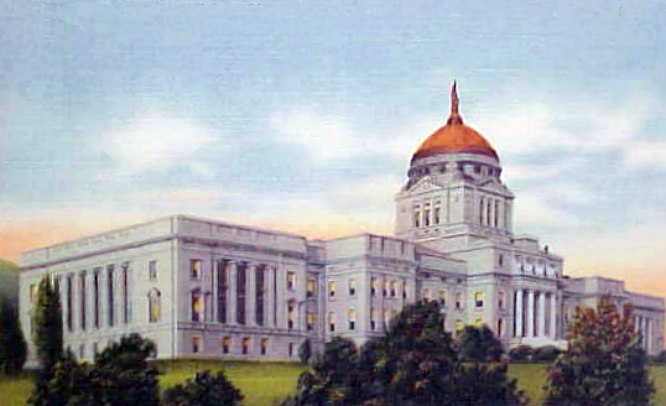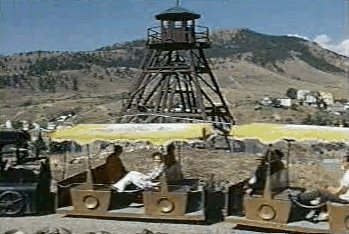|
|

|
VIEWS
OF THE CAPITOL • SOUVENIR
GOODS • ORIGINAL
CAPITOL DESIGN •
1958
AERIAL PHOTO
1905
MEAGHER STATUE •
THE 'LAST CHANCER' TOUR TRAIN
• MONTANA HISTORICAL SOCIETY
KEELBOAT
'MANDAN' • GOVERNORS
MANSIONS
|
| Excavation
for the Montana Capitol began in 1896. In 1898, the architectural
firm of Bell & Kent was chosen to design the building, which
was dedicated on July 4, 1902. The construction of the Capitol
was fraught with political corruption, including kickbacks and
substitution of inferior materials. There have been several expansions
and renovations over the years, including the highly-praised 1995-2000
interior restoration. Naturally, many images of the Capitol have
been produced over the past century. |
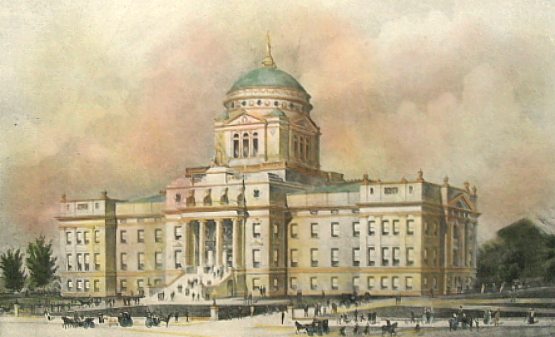
|
An 1898
illustration of the future Capitol by the architectural firm
of Charles E. Bell & John H. Kent. Note that the completed
dome in the photograph below is different than shown in this
illustration. The shape of the dome was changed during construction
in 1901.
|
|
|
Mr.
Kirby Lambert, Curator of Art at the Montana Historical
Society kindly explains:
Kent
originally designed a low spherical dome, a design he
considered to be "pure Greek." The capitol commission
initially agreed to this design, but after construction
was well under way they decided that they wanted a taller,
more imposing structure, and they thought that raising
the dome would be the most economical way to do this.
Kent opposed the changes, but Bell sided with the commission,
and we can see who won. This information comes from the
Historic Structure Report: Montana State Capitol Building
by Jim McDonald, 1981
MANY
THANKS TO MR. LAMBERT FOR THIS INFORMATION.
|
|
|
|

|
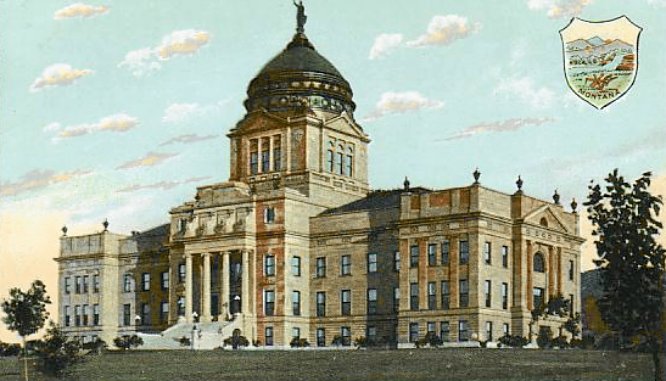
An early postcard
of the Capitol Building, before the east and west wings were added
in 1912.

|
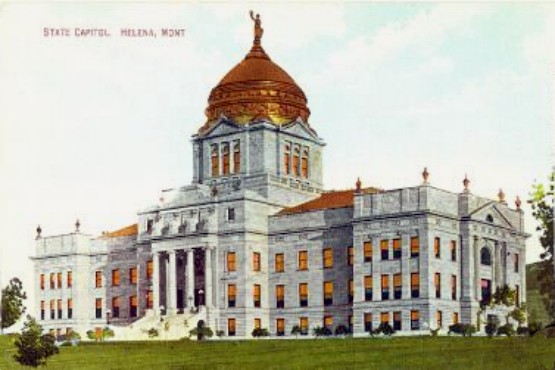
| A similar
version, with copper dome aglow. The 17' copper-clad bronze
statue "Montana" atop the dome was sculpted by Belgian-born
Edward J. Van Landeghem of Philadelphia. |

|
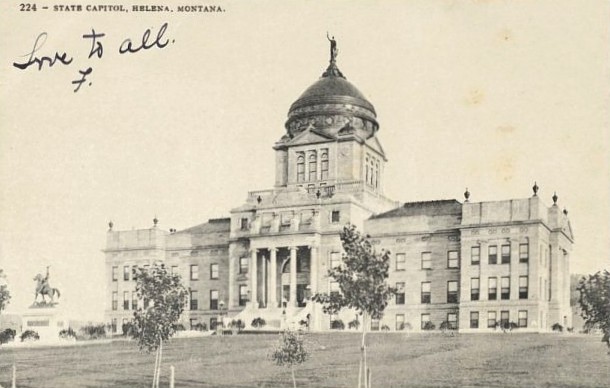
Postcard, ca.1910.

|

A color version
of the same, with State Seal.

|
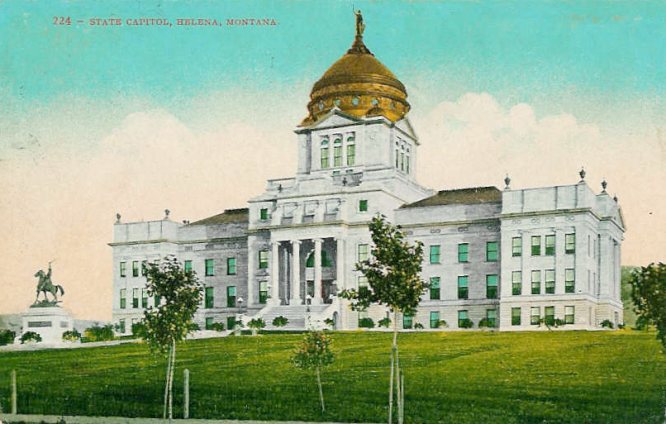
Another colorized
rendition, with azure sky and copper dome.

|
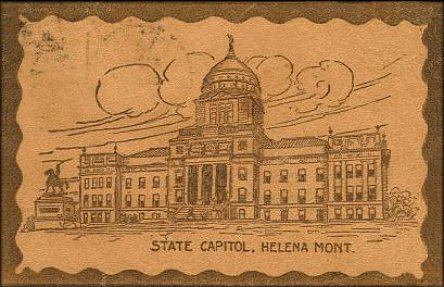
Leather postcard,
after 1909.

|
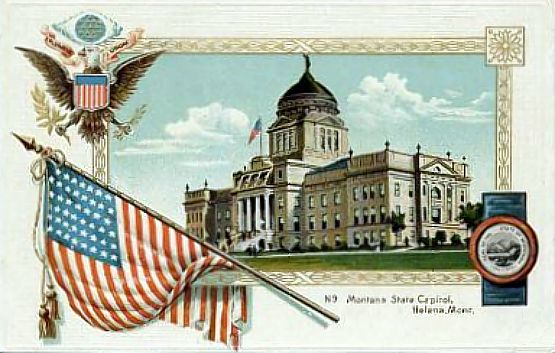
| Pre-1912
postcard of the Montana Capitol, with heavy Federal emphasis.
One in a series of State Capitol cards. |

|
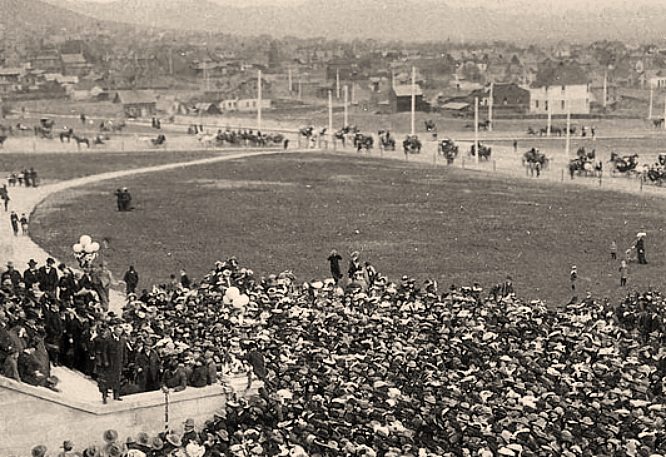
President Theodore
Roosevelt (standing on wall, lower right) speaking from the Capitol
steps, 1903.

|
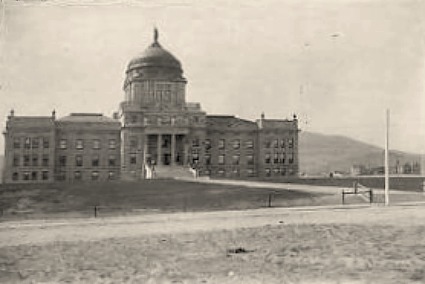
Snapshot of the
Montana Capitol, ca.1904.

|
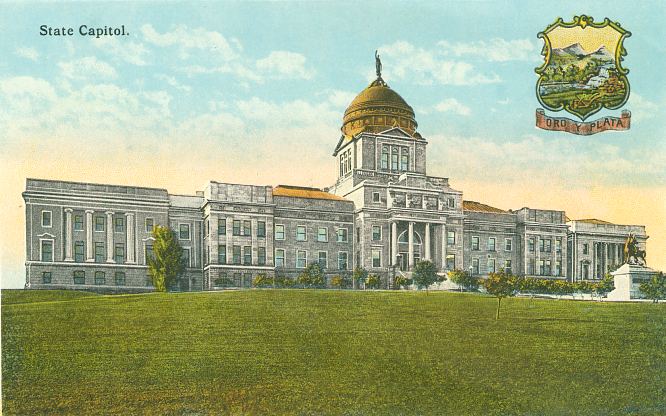
Ca. 1915 postcard
view, with the State Seal. COLLECTION
OF KENNON BAIRD

|
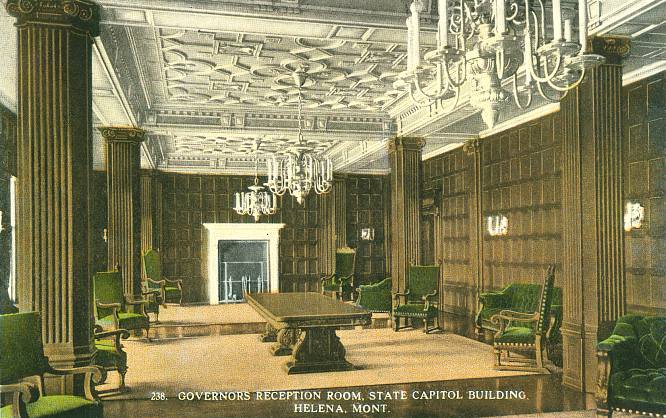
Governors' Reception
Room in the Capitol, ca. 1915. COLLECTION
OF KENNON BAIRD

|
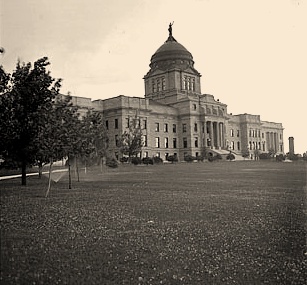
Snapshot, 1912.

|
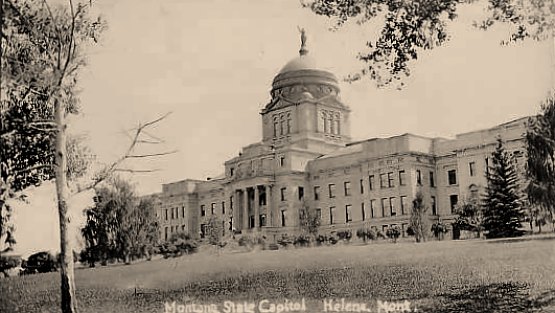
The trees are
still fairly small in this ca. 1925 image.

|
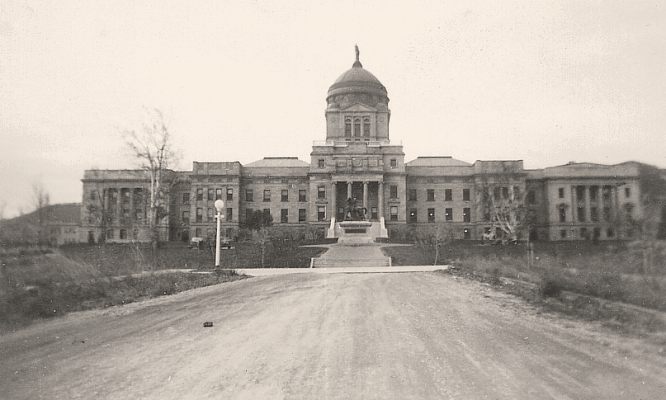
|
A
ca.1920 view of the Capitol taken from Cooke Ave., which was
still a dirt road.
COURTESY OF TOM KILMER
|

|
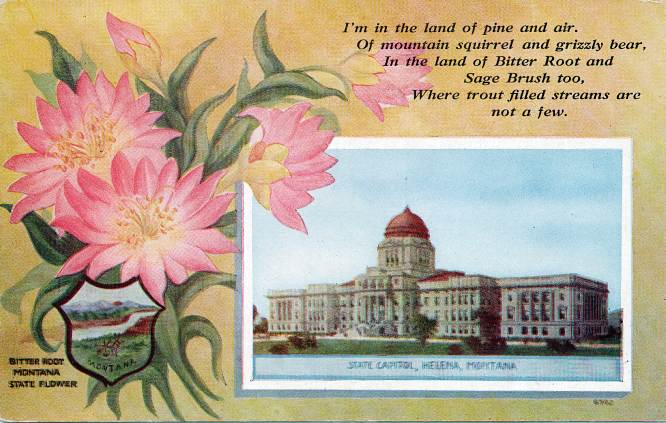
It's likely
that theartist used Bell & Kent's preliminary illustration
of the building as a model for this postcard illustration. Note
the flagpole atop the dome instead of the "Version of Liberty"
statue.
COLLECTION OF KENNON BAIRD
|

|
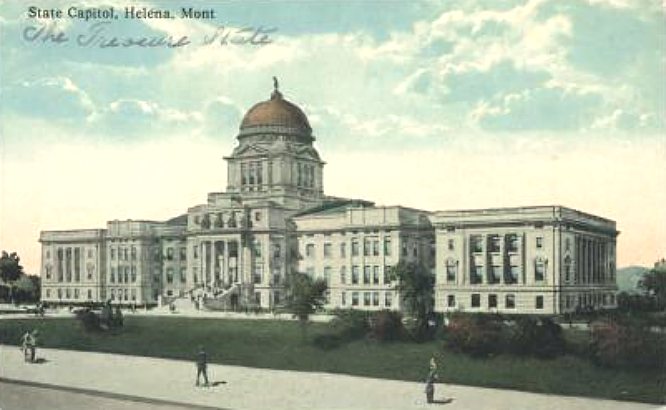
| On this version
from the same era, the statue is shown atop the dome, but the
dome is still the early version. |

|
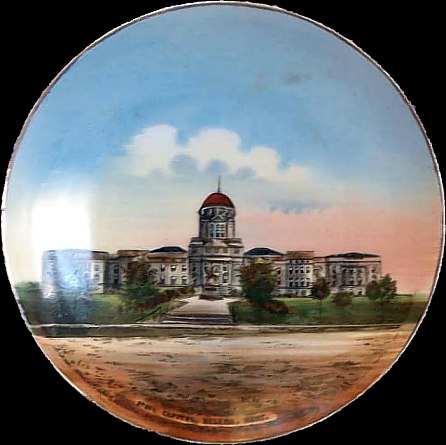
| Who would
guess this building was the Montana Capitol? Most souvenir plates
of this type were made in Germany. |
|
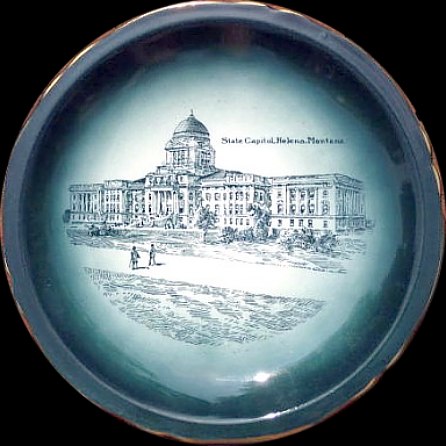
|
Souvenir
plate from Buffalo Pottery (Buffalo, New York) dated 1909. The
makers were evidently working from architectural drawings, for
construction of the two new wings had only just begin in 1909,
and wouldn't be completed as shown until 1912.
|
|
|
|
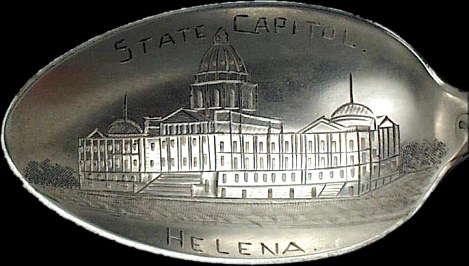
|
|
Mr. Kirby Lambert, Curator of Art at the Montana
Historical Society, comments on the odd look of the Capitol
on this souvenier spoon:
I believe that this spoon
shows the very first plans for the Montana State Capitol.
This design was drawn by George R. Mann and was selected by
Montana's 1st Capitol Commission in 1896. In 1897 it was discovered
that the
Commission was corrupt and was planning to scam hundreds of
thousands of dollars from the building project.
Ultimately, the 1st Commission
was disbanded and a 2nd Capitol Commission was convened. The
2nd commission abandoned Mann's plans as being too costly,
and selected the Bell and Kent design by holding a second
design competition. Mann's building was therefore never erected
in Montana. It was however, later selected as the design (with
a few changes) for the Arkansas
State Capitol, pictured below:
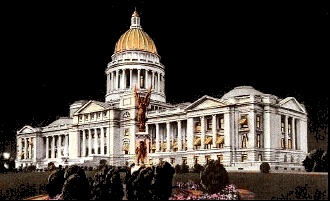
THANKS
TO MR. LAMBERT FOR THIS FASCINATING INFO
|
|
|
|

|
This
cast spoon from about 1910 has - at last - a true depiction
of the Capitol.
|

|
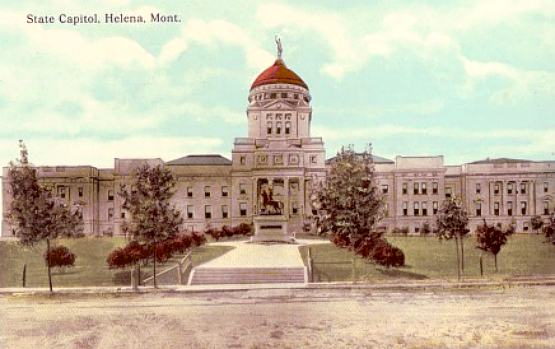 A circa 1915 view,
with a lopsided dome.
A circa 1915 view,
with a lopsided dome.

|
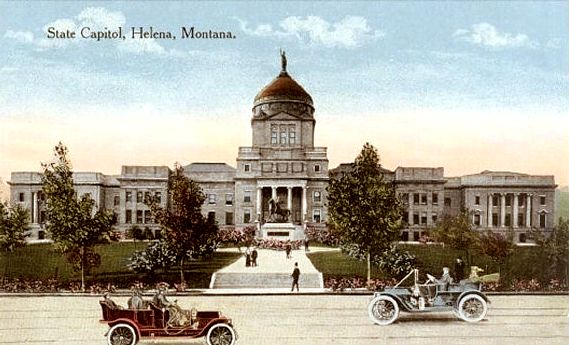
|
The
automobiles and people have been inserted into this ca. 1915
collage image.
|

|
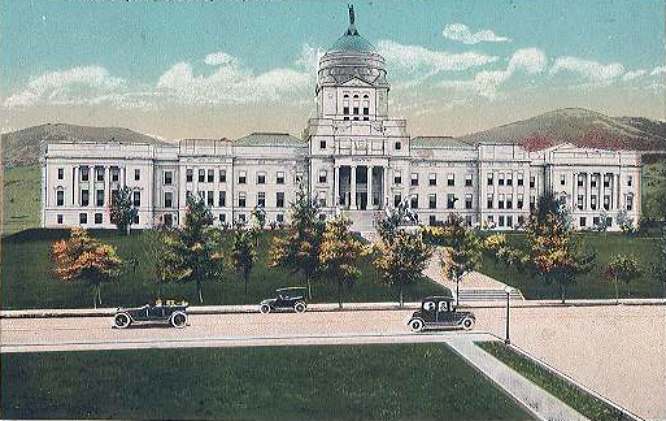
Another collaged
image, wherein eveything looks oddly two-dimensional.

|
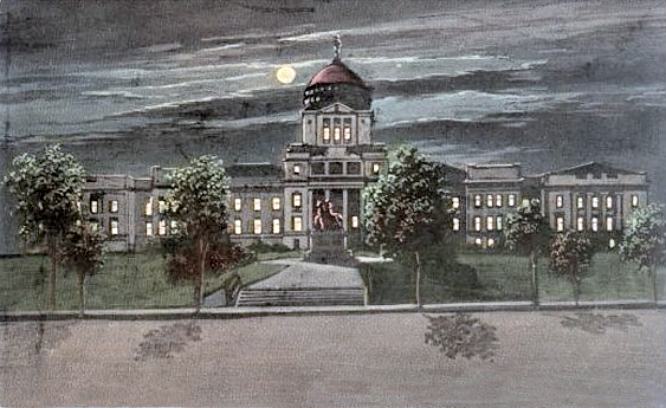
The Capitol by
moonlight. Date unknown.

|
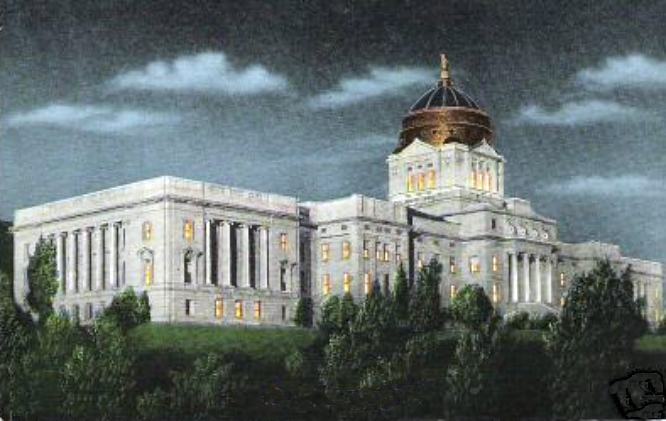
Another romantic
nocturne, probably from the 1940s...

|
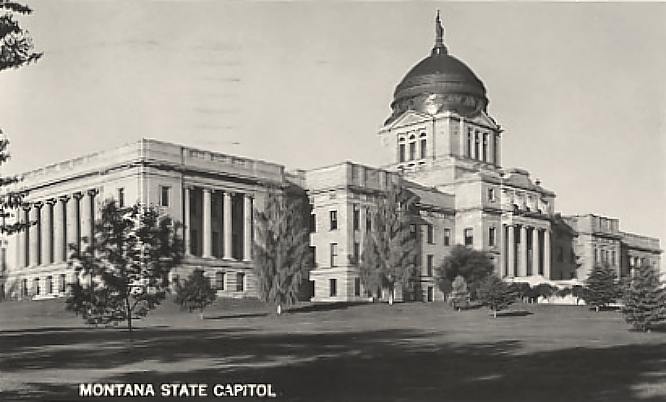
...which may have
had its genesis in this 1930s image.

|
|
Another
version of the same.

|
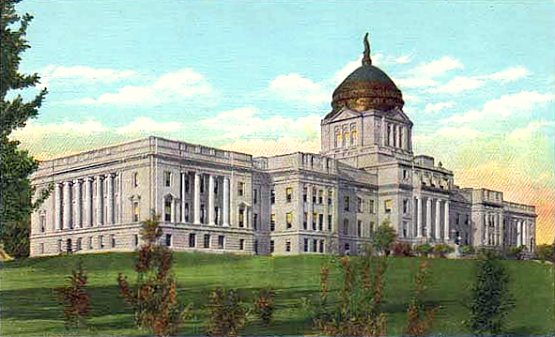
Yet again...

|
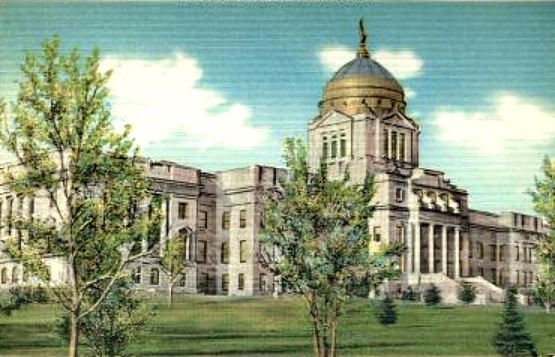
One more time.

|
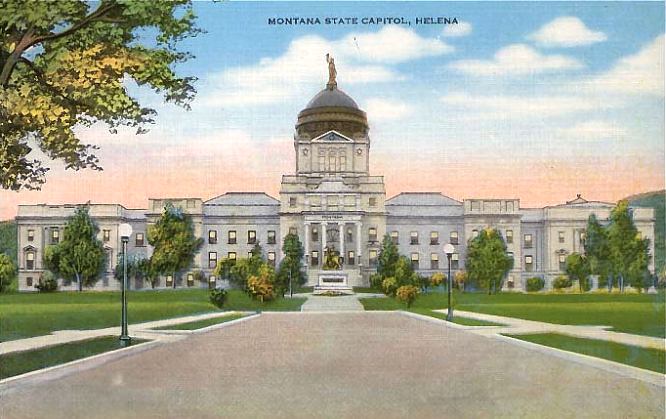
From the 1940s

|
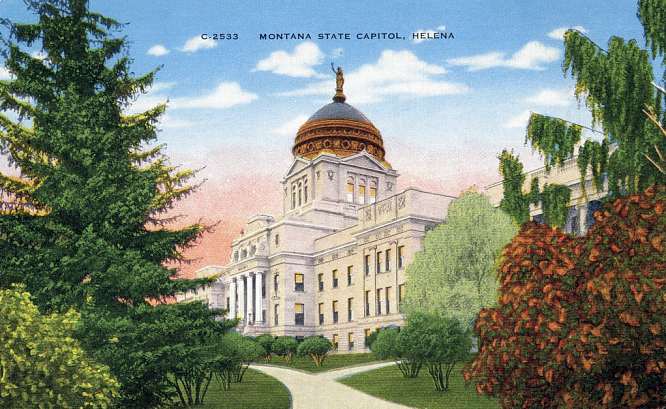
A nice view from
the 1940s.

|
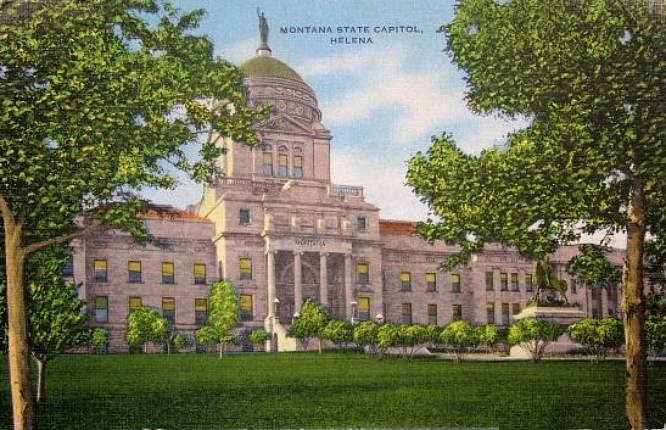
A pleasing angle,
done in interesting colors.

|
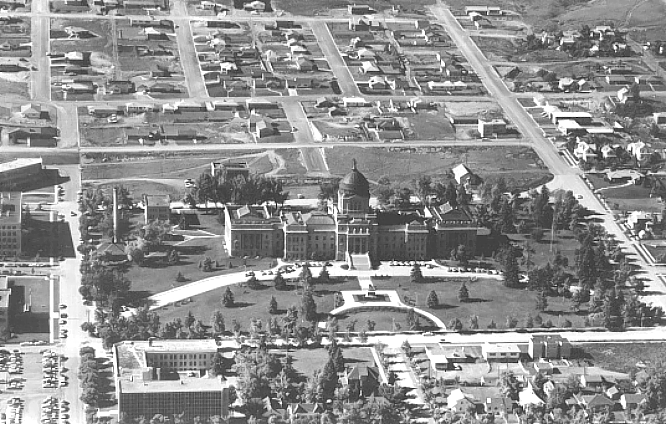
Aerial view of
the Capitol area, looking south, about 1958.

|
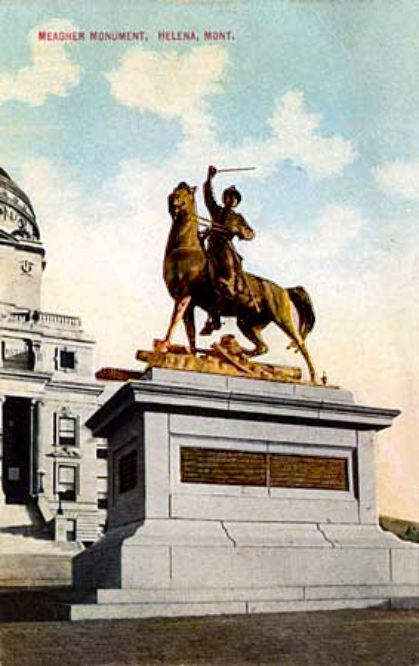
|
Bronze equestrian
statue of Thomas Francis Meagher on the north side of the Capitol.
The statue was cast in 1905 by the American Bronze Foundry,
Chicago, Illinois.
A native
of Ireland, Meagher (1823-1867) was an Irish revolutionary,
a Brigadier General in the U. S. Army during the Civil War,
and was appointed Secretary of the Territory of Montana in 1865.
Soon after arriving in Montana, he was designated Acting Governor.
He died in Fort Benton, Montana under suspicious circumstances
on July 1, 1867. For more about Meagher, go
here.
|

|
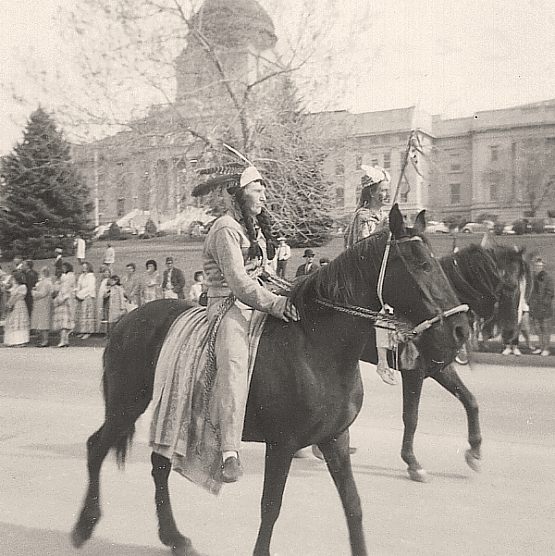
The Montana Centennial
Parade passes the Capitol, May 1964.
COURTESY OF TOM KILMER

|
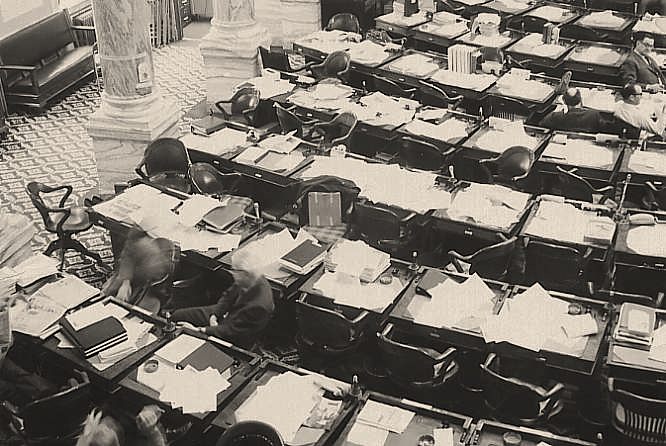
In the Montana
House of Representatives chamber, 1970.
COLLECTION OF KENNON BAIRD
|

MONTANA HISTORICAL
SOCIETY
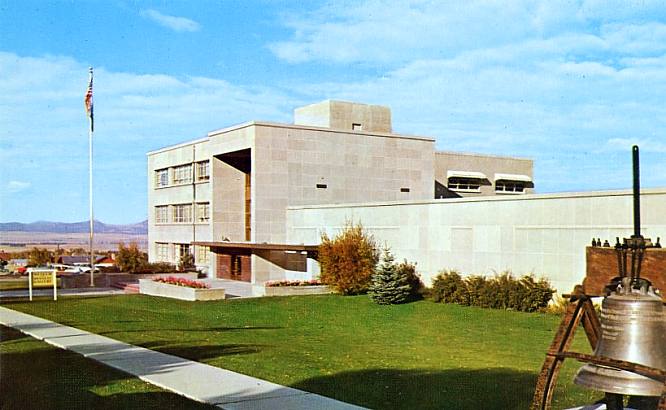
| The Veterans
and Pioneers Memorial Building, across Roberts St. from the Capitol.
Opened in 1952, it houses the Montana Historical Society. Photo
taken in the 1960s. |

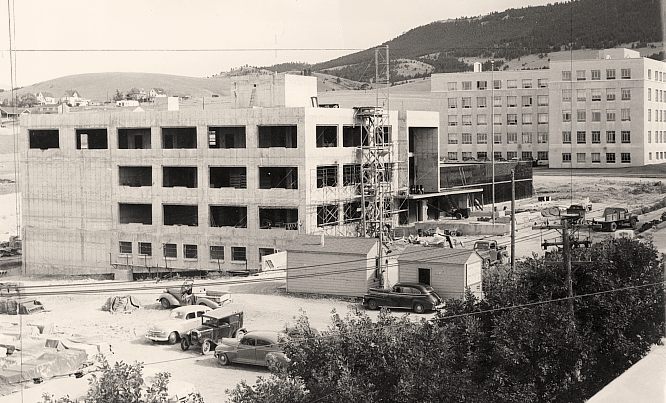
The Veterans and
Pioneers Memorial Building under construction, 1951. COURTESY
OF KATHRYN FEHLIG

|
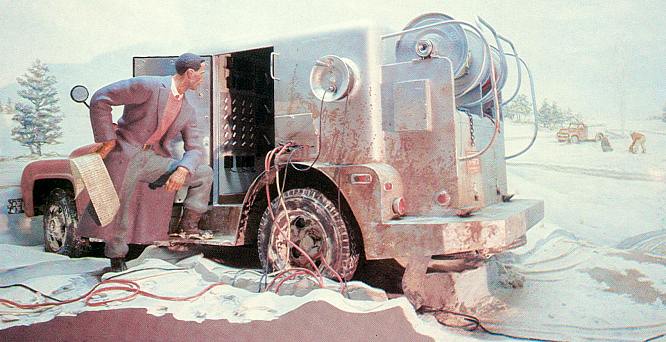
Diorama in the
State Historical Society Museum depicting exploration for oil, 1950s.
COLLECTION OF KENNON BAIRD

|
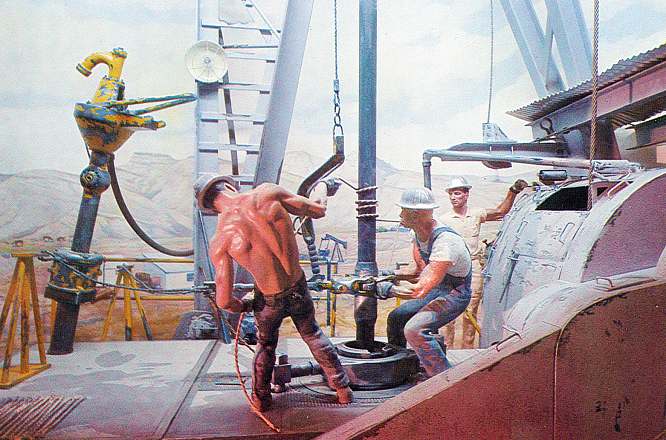
| This diorama
depicted drilling for oil. The Museum had many such memorable
dioramas during the 1950s -70s, illustrating various scenes from
Montana history and life. They were the work of Robert Morgan
and staff. COLLECTION OF KENNON
BAIRD |

|
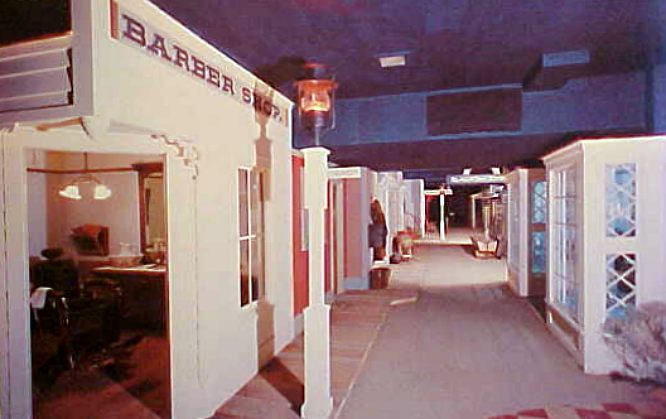
| "Territory
Junction" was a mock frontier main street which occupied
part of the lower level of the Montana Historical Society in the
1960s - 70s. It featured 13 stores and offices with authentic
19th Century fittings and items. |

|
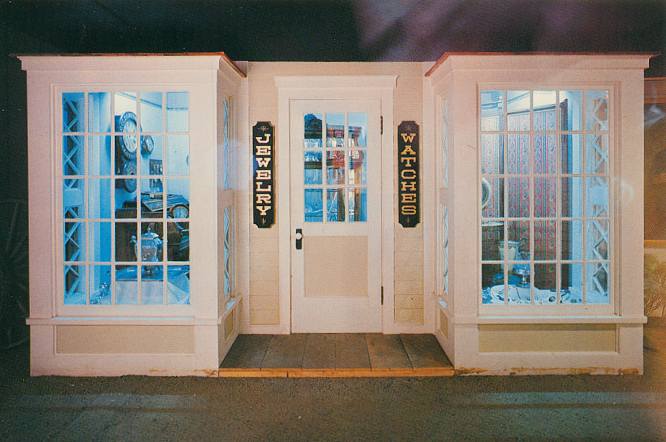
"Territory
Junction" jewelry shop.

|
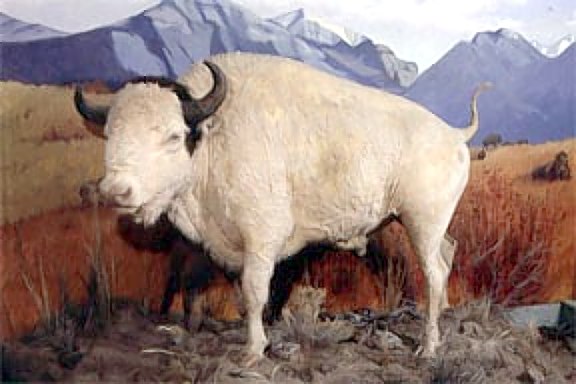
|
"Big
Medicine", the sacred white buffalo (1933-1959). Although
Big Medicine can still be seen, he has been such a memorable
part of the Museum visit for so long that he is included here.
The birth
of this white buffalo at the National Bison Range on Montana's
Flathead Indian Reservation was seen as an auspicious event
by the Confederated Salish and Kootenai Tribes. He was well
cared for, and lived beyond the normal bison life span. While
he was still alive, preparations were made by the Montana Historical
Society to have his form preserved for future generations.
|

|
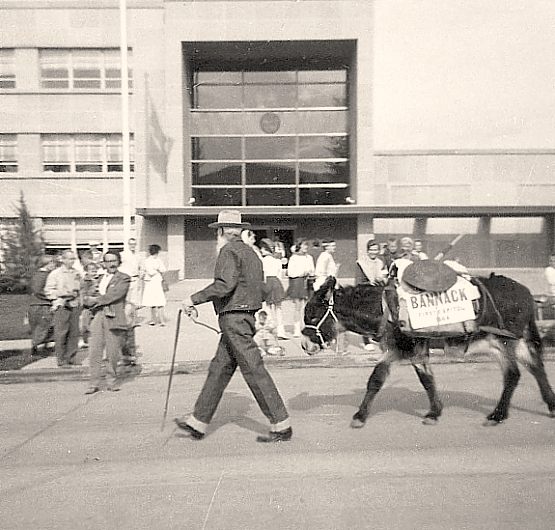
|
The
Montana Centennial parade passes the Veterans and Pioneers Memorial
Building, May 1964.
COURTESY OF TOM KILMER
|

|
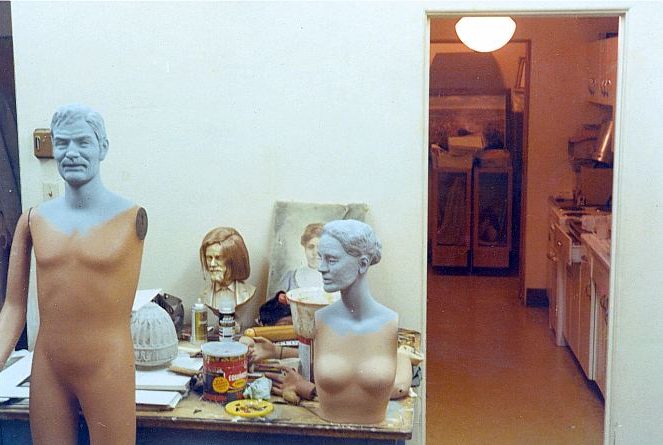
Studio in the
basement of the Montana Historical Society, 1970.
COLLECTION
OF KENNON BAIRD

THE TOUR TRAIN
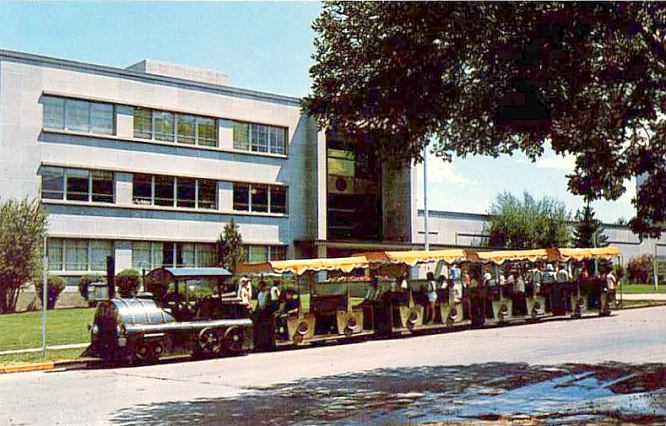
|
"The
Last Chancer" tour train at the Veterans and Pioneers Memorial
Building, late 1950s. The tour train was created in 1954 under
the auspices of "Helena, Unlimited", a not-for-profit
corporation organized by the Helena Chamber of Commerce.
|
|
|
|
A city-wide
contest was held in June of 1954 to name the train, which was
at first little more than a gold-painted jeep pulling three
cars. Some of the names suggested were "Sacajawea",
"Gulch Express" and "The Six Shooter". The
maiden run of "The Last Chancer" (winning name submitted
by Mrs. S. J. Zahara) occured on June 15, 1954. For several
years, tours began at the Great Northern depot (now demolished),
at the intersection of Neill Ave. and Fuller.
During the winter of 1954-55, the jeep was upgraded to look
like a locomotive at the State Training School in Boulder. It
was designed by Harold Jensen and executed by Clem LaVinge.
An updated
" Last Chancer" still operates today, taking passengers
on a narrated tour of Helena's historic sites. Contrary to what
the tour guide might tell you, no outlaws were ever hanged from
the trees on the Courthouse lawn.
The
Last Chancer Tour Train website
|
|
|
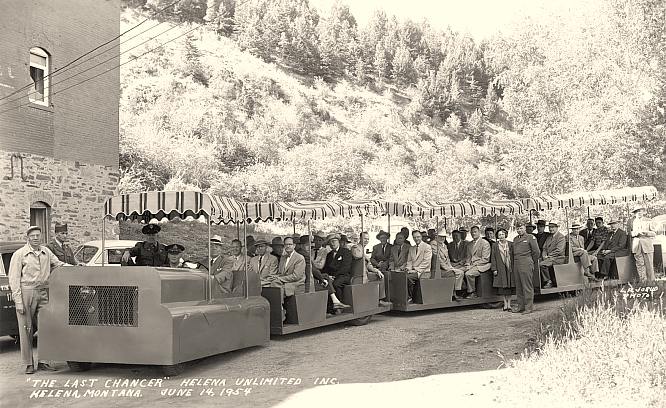
|
Publicity
photo of the first Last Chancer, taken at the Old Brewery Theater,
June 14 1954. This was the day before the official inaugural
run of the Tour Train. Seated on the train are numerous local
notables of the day, including Montana Governor J. Hugo Aronson
behind the wheel.
The
train made its maiden run the following day with H. S. "Hi"
Dotson, Norman B. Holter, Mr. and Mrs. A. T. Hibbard, Mr. and
Mrs. Marc Buterbaugh, Fred Heinecke, George Vucanovich, Vernon
Cougill, Mr. and Mrs. John Quigley, James Dion, Harold L Paulsen,
P. W. Singer, Neil MacLean, C. F. Mueller, Larry Graham, Mrs.
Sherman W. Smith, Eugene Fehlig, John G. Thompson, Clem Meyer
and Bryant B. Anderson aboard. Photo courtesy of Kathyryn
Fehlig.
CLICK PHOTO FOR A LARGE VERSION IN A NEW WINDOW
|
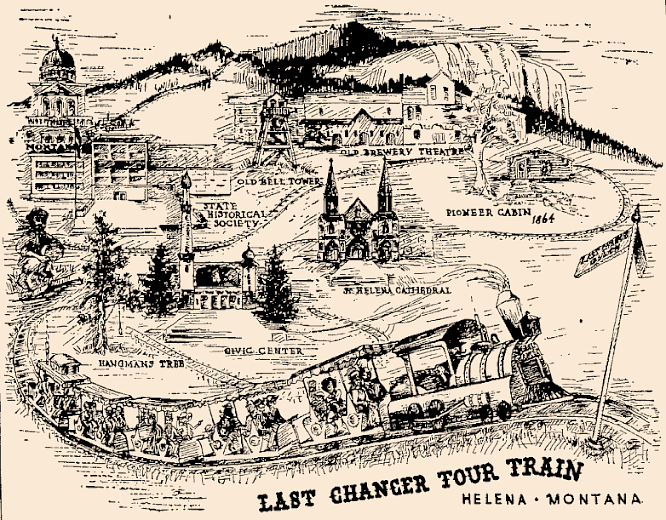
| 1955 Last
Chancer Tour Train postcard by Shirley Kemp Gannon, who also furnished
and decorated the new Montana Governors' Mansion in 1959. |
|
|
|
•
V I D E O •
CLICK ON IMAGE TO DOWNLOAD
|
Two combined
short video clips of the Tour Train in 1972, from the 1973 Helena
Chamber of Commerce promotional film
"Helena - City of Gold".
COURTESY OF KITTY ANN QUIGLEY TAALER |

|
THE KEELBOAT
"MANDAN"
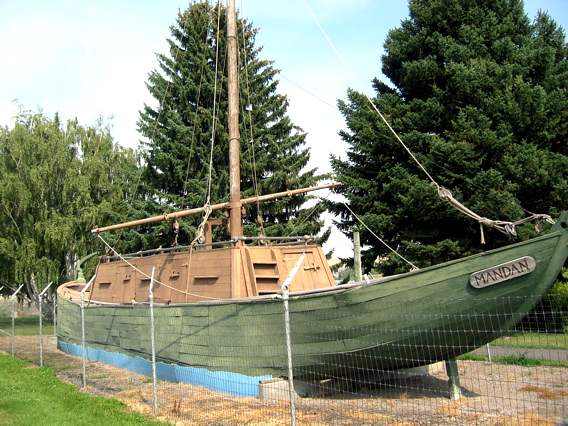
|
Above is
a recent photo of the keelboat Mandan in Fort Benton, Montana.
The boat was built for use in the 1952 RKO motion picture "The
Big Sky", starring Kirk Douglas, and adapted from Montanan
A. B. Guthrie's novel.
After filiming
was completed in Wyoming, the boat was shipped to the Historical
Society in Helena, and put on unprotected outdoor display in
back of the Veterans
and Pioneers Memorial Building. In true Helena fashion, it was
immediately vandalized. A fence was built around it, and it
remained on display for many years.
It was eventually loaned to the city of Fort Benton, and was
officially deaccessed by the Montana Historical Society in 2005.
|
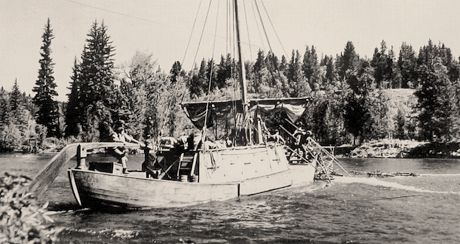
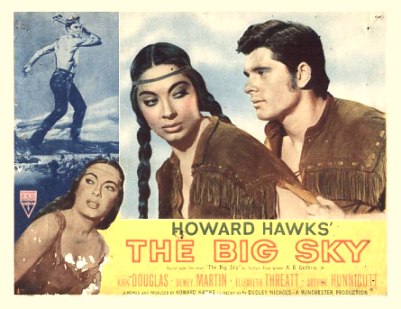
Still and lobby
card from "The Big Sky"
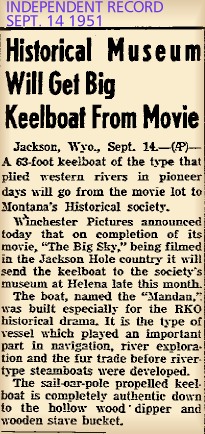
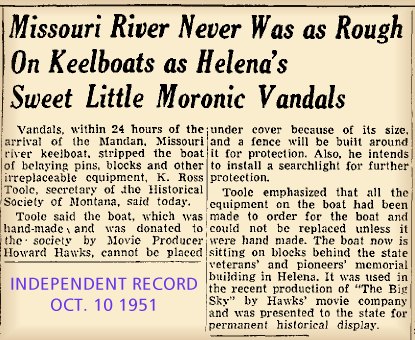
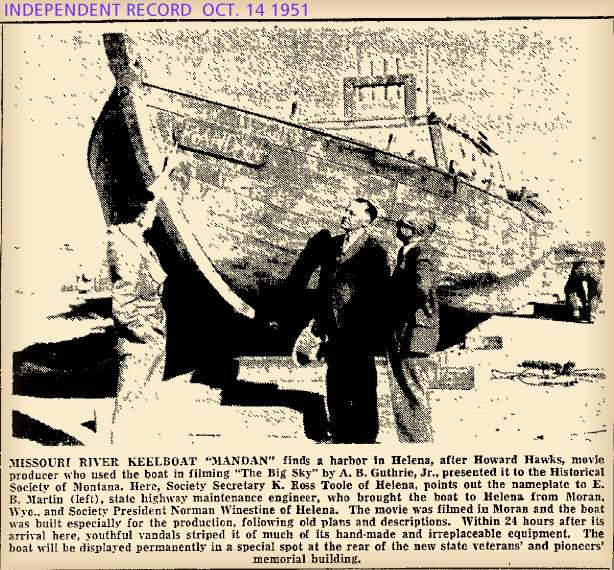
|

GOVERNORS' MANSIONS
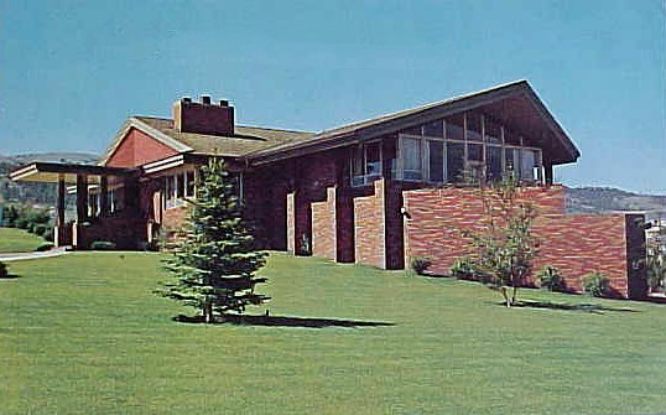
| The "new"
Montana Governors' Mansion, near the Capitol at 2 Carson Street.
It was built in 1959 for $347,000 (about $2,300,000 in today's
dollars), and furnished and decorated by Shirley Kemp Gannon for
$58,000 (about $390,000 today). The house was designed by architect
Chandler C. Cohagen of Billings. The front door faces east but
the house is oriented to the north, with floor-to-ceiling picture
windows looking out across the Helena Valley.
The house was built by Mel Buck Construction on land donated
by C.F. Mueller of Helena, who lived in the neighborhood. There
were problems during construction; at one point, delays, cost
overruns and low-grade materials had a Montana House of Representatives
committee threatening to turn the building into the headquarters
for the highway patrol.
Click
here for a 2005 Independent Record story about the Mansion.
|

|
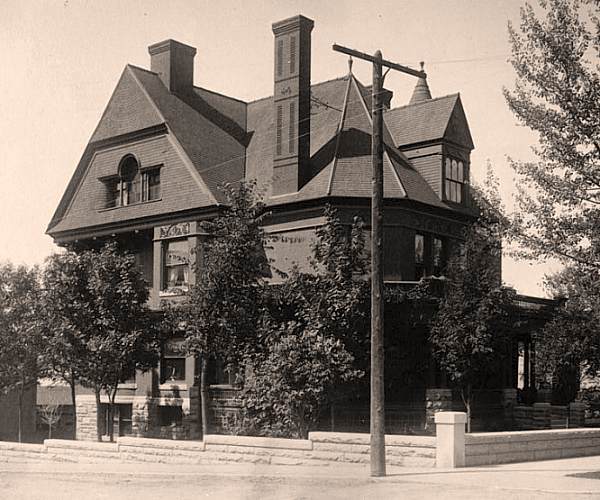
Pre-1935
view of the original Governors' Mansion, northwest corner of
Sixth Ave. and Ewing, taken from Sixth. Built as a private home
by Helena industrialist William A. Chessman in 1885, it was
purchased by the State in 1913 for use as the executive residence.
It has been restored, and is open for public
tours.
|
|
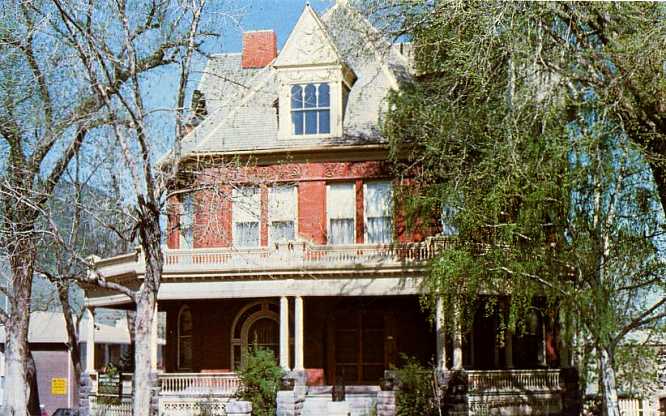
|
Recent
photo of the original Governor's Mansion, taken from Ewing St.
|

|
















